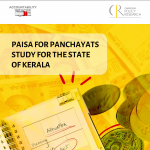
Strategies for Eliminating Corruption in the Healthcare Sector
28 July 2019
This blog is part of a series. The first blog can be found here.
There are both generic and specific solutions to the problem of corruption in the health sector. Even though it is important to punish people who solicit and give bribes, we should also concentrate on addressing the environments that provide incentives for corruption. In this direction, many tried and tested generic solutions are useful in reducing petty corruption to a large extent. However, more specific solutions are required to tackle grand corruption, or the corruption that occurs due to the breakdown of moral ethics in the medical profession, wherever it occurs. Some of the ways in which corruption can be tackled in the health sector are below.
One could ensure vigilance over the quality of health services provided, through proper evaluation. Some of the ways in which this evaluation of the quality of health services can be done:
- Internal assessment of health facilities through self-assessment and assessment by higher levels.
- External assessment can be undertaken through regular client surveys. There are many models that one could use for this purpose. One way is to give a format to people who are waiting or who have received services, to assess the quality of the service provided. In the case of illiterate or semi-literate patients, it may be necessary to do this through assistance. The counselling centre could take up such regular surveys.
- Ranking of facilities and giving high publicity could be undertaken. The media has a huge role to play in partnering with the government to reduce corruption. Regular publicity given to information on corruption, including a ranking system for hospitals could be a way to introduce a system of healthy competition. Rewards could also be offered to celebrate instances of systemic clean-up in health facilities, with a jury of individuals who are known for their impeccable integrity, and who are role models for society, judging the best facility.
- Government hospitals need to be categorised according to the nature of specialisation and the referral system within the government structure ought to be made functional. This will ensure that general hospitals would not be empowered to force patients to unnecessarily undergo tests that are beyond their reach. However to hone the skills of general doctors from these hospitals, all staff must be rotated to higher specialised centres on a regular basis.
Some simple steps would go a long way in rapidly reducing petty corruption in hospitals.
Providing complete information to the public
Providing proper information to citizens on their rights and of the procedures they have to follow can substantially reduce petty corruption.
- Proper signage in hospitals, stating out clearly what services are provided, by whom, where, the price, where to pay etc.
- Standardisation of some of the charges, such as doctors and lab test fees.
- A citizens’ charter listing out the obligations of health staff in provision of services.
- An integrity pledge or integrity pact[1] can be signed, which lays out a pledge of integrity, broken up into specific ‘do’s and don’ts, which should be prominently displayed in the facilities. This can have the effect of being a permanent reminder to all the staff of the high ideals to which they are committed.
- A help-desk cum counselling centre, handled by experienced, friendly and well trained counsellors, who are able to hand hold patients and help them through the procedures. The counsellors might need to be changed regularly, so that vested interests are not developed. Counsellors could also be empowered to register complaints against corruption. This will enable the public to feel safe and secure to report and see that action is taken against the culprit.
Also, there is a special need to inform the public, so that they can form opinions against the prevalence of unethical practices.
Essentially, one must ensure that patients know about these practices. When then there is information transparency, patients will then have to decide whether this is right or wrong. This can be done by starting discussions, promoting greater awareness and exposing the problem. If people think that a particular practice is not illegal, then let it be made fully legal, but with an obligation to be fully transparent. If people think that something is not a right practice, then we must have stricter laws to curb it. That will create a deterrent effect.
Also Read: How the Lack of Information Can Affect Health Insurance Schemes
Streamlining procedures and increasing efficiency is another.
Improved technology and management procedures should be adopted to enhance efficiency and reduce long queues in health facilities. Some systems are quite simple, and include:
- Having more counters for visitors at every level and enlarging the number of outpatient examination rooms based upon pre-defined doctor-nurse-patient ratios.
- Introducing a token system to eliminate queuing up;
- Introducing self-queuing, through online booking of health appointments,
- Close circuit cameras to ensure that bribes are not taken at access control centres; Either doors are closed or open, but when they are closed, nobody is allowed; A connected reform would be to re-examine unnecessarily harsh timing restrictions on visitors to patients.
In my next blog, I will focus on the steps for tackling syndicated or grand corruption in the health care sector.
_________________________________
[1] Integrity pacts have been devised by Transparency International for reducing corruption in procurements. For knowing more, please go to: http://www.transparency.org/global_priorities/public_contracting/integrity_pacts.
The same approach could be adapted for a more general objective of improving consumer services in health facilities.





